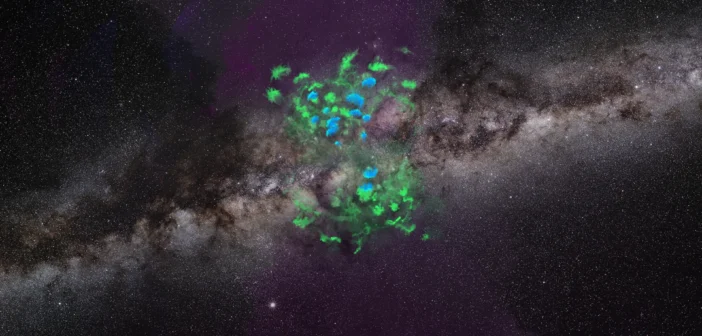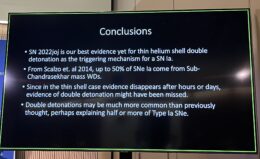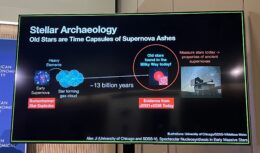Editor’s Note: This week we’re at the 243rd AAS meeting in New Orleans, LA. Along with a team of authors from Astrobites, we will be writing updates on selected events at the meeting and posting each day. Follow along here or at astrobites.com for daily summaries, or follow @astrobites.bsky.social on BlueSky for more coverage. The usual posting schedule for AAS Nova will resume on January 16th.
Table of Contents:
- Henry Norris Russell Lectureship: Frank Shu’s Legacy in Unraveling Star Formation, Susana Lizano (Instituto De Radioastronomia Y Astrofisica)
- Press Conference: Supernovae and Stars
- Annie Jump Cannon Prize Lecture: Marta Bryan (University of Toronto)
- Press Conference: Stars, Disks & Exoplanets
- Plenary Lecture: Investigating the Early Universe, Jamie Bock (California Institute of Technology)
- Newton Lacey Pierce Prize Lecture: Characterizing the Properties of Accreting Neutron Stars through X-ray Observations, Renee Ludlam (Wayne State University)
Henry Norris Russell Lectureship: Frank Shu’s Legacy in Unraveling Star Formation, Susana Lizano (Instituto De Radioastronomia Y Astrofisica) (by Ivey Davis)
Frank Shu was a titan of astrophysical fluid dynamics theory, with his work being seminal to our understanding of star and planet formation, protoplanetary (and planetary) disk structure, galactic spiral arm formation and stability, and nigh countless other topics across essentially all fields in astrophysics. He was awarded the Henry Norris Russell Lectureship before his passing in April of 2023. Upon being awarded the Lectureship, he not only requested that Susana Lizano give this lecture on his behalf, but also donated the associated money back to the AAS. In honor of Shu’s contribution to astrophysical fluid dynamics, and astronomy as a whole, Lizano gave an overview of Shu’s career, which in a way is an overview of the field of star formation theory.
Shu’s first work was addressing the spiral structure of galaxies by treating them as density waves propagating through a disk, rather than as fixed, physical structures as had originally been assumed. This new framework solved the winding problem that had arisen in the fixed-structure framework, as well as addressed other galactic features like color gradients and the locations of OB star associations. Similar density-wave treatments would later be applied to other places we see disks, such as in Saturn’s rings and in the material around young or forming stars.
In 1977, Shu published his work on the collapse of spheres of gas as a way to explain core formation and subsequent star formation. A decade later, he, along with Lizano and Fred Adams, would publish the review that is still used as the star formation paradigm, showing how pressure, temperature, and density evolve with time to eventually form young stellar objects from molecular gas clouds and also explains the onset of the Hayashi track. Expansions of this work to rigorously analyze the effects of magnetic fields and rotation on gaseous bodies, both by Shu and by others, would go on to explain or elaborate on evolutionary sequences from protostars to main-sequence stars, the scale height and aspect ratio of accretion disks, disk formation conditions, planetary migration, planetesimal formation, and so much more.
Shu was an active researcher and astronomical community member, serving as president of the AAS from 1994 to 1996, and most recently was investigating technologies to help combat the climate crisis. Questions following Lizano’s talk not only included questions about what the future of the field looked like, but also recountings of individuals’ personal experiences with Shu. This lecture was a truly heartfelt tribute to a dedicated astronomer and mentor.
Press Conference: Supernovae and Stars (by Mark Popinchalk)
This press conference was all about stars going supernova! (Except for one result about galactic gas that was shuffled into the session due to a missed flight.)
A 12.4-Day Periodicity in a Close Binary System After a Supernova (Press release)
First, Ping Chen (Weizmann Institute of Science) shared a peculiar system with us. You can measure the kind of light a supernova gives off to see what elements are in it. It may have some hydrogen, or helium, or neither. This is often thought to be due to what the outer layers of the star were doing before the explosion. The dense core will stay put, but the outer layers of hydrogen or helium may or may not get stripped off. Whether this stripping always occurs, and how it happens, is hotly debated.
The case of the supernova SN 2022jli is especially weird. Its brightness shows a periodic dimming and brightening on a 12.4-day period, which is already unique. It becomes even more interesting that the spectra of the supernova usually doesn’t show hydrogen, except for particular points in the 12.4-day period!
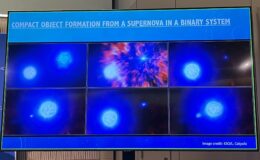
A six-panel slide from Ping Chen’s talk showing the orbital interactions of the compact supernova survivor and its binary companion.
The story appears to be that there were two stars in a binary system, one that went supernova and is now a compact object, and the other a star in an elliptical orbit around the remnant. When the outer star approaches the remnant on its orbit, the remnant strips some hydrogen from the outer star and the extra hydrogen is added to the remnant’s spectra. The outer star has to be on an elliptical orbit so that the stripping only occurs at certain points during the star’s orbit.
Interesting!
Rare Insight Into the Origins of Type Ia Supernovae Progenitors From a Double Detonation (Press release)
Estefania Padilla Gonzalez (UC Santa Barbara and Las Cumbres Observatory) introduced the audience to a great candidate for a double detonation Type Ia supernova. She started by introducing us all to Type Ia supernovae. They have predictive luminosity, which is to say that the light from their explosions are understood really well, and they have been used as “standard candles” to enable distance measurements to other galaxies.
Even though they are well understood, there are still some questions on how Type Ia supernovae explode. The common understanding is that to have a Type Ia supernova you need a white dwarf that is under 1.4 solar masses, the Chandrasekhar limit. Then you need another nearby star to feed mass onto the white dwarf until it crosses that limit, and boom! Supernova!
However, there may be sub-Chandrasekhar-mass explosions. Their occurrence is not currently supported by observations, but they are theoretically possible. How can we get the smaller stars to explode? The idea is that the helium layer surrounding the core of the star starts to ignite early, which causes a shock wave that travels around the star. When the shock waves meet each other, that provides even more force that could trigger the rest of the core to go full supernova.
And that’s where the team’s research comes in! SN 2022joj is a Type Ia supernova that has a few different characteristics, a non-standard candle. For example, there is suppression in the blue wavelengths of the light it emits, which might be due to helium ash absorption at those wavelengths. However, once the full explosion occurs, the end result looks like a regular Type I supernova.
It’s an exciting candidate for a double detonation of a thin helium shell!
Periodic Eruptions of a Supernova Impostor
Mojgan Aghakhanloo (University of Virginia) was next, and had an intriguing system, an impostor supernova! SN 2000ch is the impostor in question, and it’s thought to be an evolved massive star that has undergone non-terminal eruptions. What does that mean? It’s a big star that’s not dead yet. Eta Carinae is a great example that some might be familiar with — huge outer layers barely contained in its gravity influence, a star that is just clinging to life. It went through a “Great Eruption” in the past.
SN 2000ch is having an even worse time. Since 2000, it’s had 23 different eruptions, and the team has shown that there is an interesting periodicity to it, that the eruptions occur approximately every 200.7 ± 2 days. What’s the cause? It’s probably another binary system!
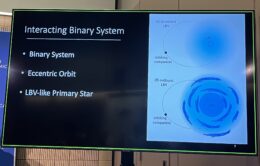
A summary slide from Mojgan Aghakhanloo’s talk showing the binary orbit interacting with the outer layer of the massive star.
The big evolved star is not by itself and has a secondary companion in the system, orbiting around it. As the other star gets close, it passes through the outer layers, causing eruptions. And since the layers are so extended, it is likely that the material the path goes through changes, explaining why some eruptions are bigger than others.
These eruptions look just like those that Eta Carinae went through, and makes this a target of “great interest.” The next eruption is likely in March of this year!
Spectacular Nucleosynthesis from Early Massive Stars (Press release)
Alexander Ji (University of Chicago) brought us a really interesting story, a star with such a bizarre composition, that it likely formed from the supernova of a really big star! That’s right: learning about an older star by looking at a current one.
SDSS is a huge survey mission that is “lawn-mowering the sky” taking spectra of stars. It discovered a star with spectacular composition. J0931, an old star, has unusually low magnesium abundance for its metallicity, and was flagged for follow up by the Magellan telescope. The additional observation showed that it also had strangely low amounts of sodium, and tons of strontium.
What does that all mean? Well, if they trace back to when the star is likely to have formed (~10 billion years ago), it must have come from a peculiar cloud of material to have these kinds of elemental ratios. These kinds of elements only form when a star goes supernova, and when compared to theoretical models of the kind of star that would need to go supernova to make that peculiar cloud, (to form the smaller star that exists today) it would have to be massive.
So massive, that it would have to be > 50 times the mass of our Sun, even up to 80 solar masses. The challenge is that no model fits all the element ratios they find, and most models predict that stars that big shouldn’t even go supernova! A star that big should collapse directly into a black hole. The presence of this star shows that the existing supernova models are too simple, and that this particular star is a blockbuster.
They’ve given it a special name since they were working on it this summer: The Barbenheimer Star : )
The Nuclear Outflow from the Milky Way (Press release)
Last but not least was Jay Lockman (Green Bank Telescope), who had finally made it to AAS after flight troubles and was given a chance to speak at this press conference rather than the one he missed.
He pointed out that when we look at most large galaxies, they have bursts of energy in their cores that drive winds which carry mass out from the galaxy center. There is data to suggest a similar effect is happening in the Milky Way, but it is hard to see since we are in the plane of the disk. However, there are new observations that show that cold hydrogen clouds are being pushed by the hot wind from black holes or starbursts in the center of our galaxy.
A good analogy would be that the forces pushing from the center of the galaxy are an astrophysical mixture of a snow blower and a leaf blower! The movement of the gas is in straight lines out from the source and then spreads out, which is what a snow blower does. However the gas is being pushed around like leaves by a leaf blower. An autumnal/winter analogy!
The team has been attempting to locate over 300 clouds with the Green Bank Telescope. The flows are coming out in two cone shapes, at high velocities, with some clouds approaching the escape velocity of the Milky Way. They likely won’t escape, but it shows that the forces can certainly launch material around the galaxy!
Annie Jump Cannon Prize Lecture: Marta Bryan (University of Toronto) (by Ali Crisp)
In her lecture, 2023 Annie Jump Cannon Prize award winner Marta Bryan led us through her research on the dynamics of giant exoplanets and how dynamics can provide insight into the formation mechanisms of giant planets, their impacts on other planets in their systems, and even how they affect the potential habitability of a system.
To begin, she briefly explained what planetary properties we can learn from more “traditional” exoplanet studies using the radial velocity and transit techniques: the mass of the planet from radial velocity measurements, the radius of the planet from transit detections, and the orbital period, inclination, and eccentricity from either. She then adds that with new atmospheric detections, you can get information about the composition, spin, planetary obliquity, and weather on a giant planet.
But what does combining all these properties tell us? For one thing, characterizing planetary spin and comparing it to the host star’s spin can give us information about how the planet and star formed. In a perfect system, the spin of the star and planet would be aligned, and their equators would be parallel. However, we see even in our own system that this isn’t the case. Uranus, for instance, is tilted on its axis 98 degrees relative to the equator of the Sun, and Venus spins in the opposite direction from all the other planets. Constraining the orbital dynamics of exoplanets and finding any misalignments or spin oddities can indicate some sort of gravitational interaction occurred. In systems with close-in super-Earths and far-out giant planets, these suggested interactions could indicate that the giant planet caused misalignments or spin changes through, e.g., migration during its formation.
Bryan ends by contextualizing her observations and constraints in the search for biosignatures. As the number of confirmed exoplanets increases, it becomes impossible for us to characterize all their atmospheres. Since we know our own solar system hosts life and contains both close-in terrestrial planets and far-out gas giants, we could prioritize observations of similar systems for biosignatures and hopefully help constrain what constitutes habitability.
Press Conference: Stars, Disks & Exoplanets (by Isabella Trierweiler)
This session provided new insights into a variety of planetary systems and included two projects led by undergraduate students!
Stellar Paternity Tests: Matching High-Latitude B Stars to the Open Clusters of Their Birth (Press release)
Brandon Schweers and Ginny McSwain (Lehigh University)
Star formation in the Milky Way is generally believed to be restricted to the thin disk of the galaxy. However, there is an interesting population of B-type stars that have been observed far outside of the thin disk. Brandon Schweers, an undergrad at Lehigh University, sought to trace back the trajectories of these so-called “orphan” B stars to figure out whether they did indeed form in the thin disk and migrated away from home, or whether they represent a different pathway for star formation.
Schweers used kinematic data from Gaia to reconstruct the trajectories for stars in and around clusters over the past 30 million years. They then used those trajectories to see whether orphaned stars ever crossed paths with a potential “parent” cluster. Overall, Schweers found 22 intersections between orphan stars and parent clusters, with some stars intersecting multiple clusters. To validate whether the paired orphans and parents were indeed related, Schweers constructed color–magnitude diagrams for the parent clusters and checked whether the orphaned stars fell within the cluster’s parameter space. From this analysis, Schweers found 15 matches between orphan stars and parent clusters and was able to estimate the times at which the stars were originally ejected from their host clusters, as well as the initial velocities at the time of ejection. Based on the ejection velocities, Schweers found that one star was ejected due to a very energetic event, like a supernova, while the rest were likely ejected due to dynamical interactions with their parent cluster. Interestingly, a few orphan stars never intersected with any clusters, bringing up the question of whether there may be some star formation going on above and below the thin disk after all.
Weakened Magnetic Braking in the Exoplanet Host Star 51 Pegasi (Press release)
Travis Metcalfe (White Dwarf Research Corporation)
51 Pegasi (51 Peg) is one of the most famous stars in exoplanet science, as it hosts the first exoplanet astronomers ever discovered around a main-sequence star. Despite its planet being so well known, Travis Metcalfe showed that there is still more to learn about 51 Peg from its magnetic field structure. 51 Peg is a Sun-like star, which means it was likely born with a rapid spin and eventually slowed down as it shed angular momentum. The main mechanism for slowing rotation in a young star is called magnetic braking, where angular momentum is carried away by stellar winds, and the rate of the loss of angular momentum is depending on both the strength and complexity of the magnetic field around the star.
To map the magnetic field structure around 51 Peg, Metcalfe used data from the Large Binocular Telescope to first map the magnetic surface of the star and then reconstruct the magnetic field lines. Interestingly, he found that 51 Peg follows an unusual trend in magnetic braking where young, rapidly rotating stars have relatively strong braking, and then somewhat suddenly fall to a weakened braking state as they age. While the source of the drop is not entirely clear, it may have to do with changes in the complexity of the magnetic field structure around the aging stars. The Sun seems to have gone through this drop in braking as well, and curiously the timing of the drop in magnetic braking corresponds to emergence of land-based life on Earth, raising the question of how magnetic evolution of host stars and planet habitability may be intertwined.
JWST’s New View of Beta Pictoris Suggests Recent Episodic Dust Production from an Eccentric, Inclined Secondary Debris Disk (Press release 1, press release 2)
Christopher Stark (NASA Goddard)
Beta Pictoris is another well-known exoplanet system, remarkable both because its two known exoplanets reside in a debris disk and because it has shown evidence of exo-comets. Beta Pictoris’s debris disk has been a point of interest for decades, and more recently it was shown to have two components: an edge-on main disk and a somewhat warped secondary disk with interesting CO emissions. The complexity doesn’t stop there though; using NIRCam and MIRI data, Christopher Stark showed that even more features are hidden in Beta Pictoris’s disk!
The new MIRI images show a fork, an elongated feature (named the “cat’s tail”), and several shorter nebulous features. The data show that these features are connected to the secondary disk of Beta Pictoris, and that the material of the secondary disk appears to be different both in temperature and in composition from the main disk. Stark says the secondary disk material seems to be consistent with fluffy, organic, refractory material, not unlike the samples obtained by OSIRIS-REx. As far as the origins of the cat tail and other features, the most likely explanation is that they are the tails left by collisions within the debris belt. Stark showed that such a collision would need to occur in about the last 150 years to create the observed features, and furthermore that the shape of the cat tail is consistent with the same organic, refractory material extrapolated from the MIRI data. To complete the picture, the 150-year estimated timescale fits nicely with the observed CO emission. CO dissociates in about 150 years, so the observed CO would have been created relatively recently, and the collision that created the cat tail is a perfect candidate for emitting CO into the disk! Stark noted that in addition to providing more insight into the Beta Pictoris disk, these observations prove that debris disks could be a lot more active than we previously thought and should definitely be further investigated using JWST.
How Do Ultra-Massive Planets Form? Gaining New Insight by Measuring the Orbital Tilt of a Rare Transiting Brown Dwarf (Press release)
Steven Giacalone (Caltech)
Thus far, planets have been observed at a huge range of size scales, from our terrestrial planets up to Jupiter masses. However, there’s currently a gap between objects of Jupiter mass and low-mass stars. The few ultra-massive planets / brown dwarfs in this gap are intriguing objects, and their origins are an ongoing question. There are generally two options for their formation: either they form like planets, accreting in disks around stars, or they form like binary stars and collapse directly from gas. So far, most of the brown dwarfs appear to have orbits and compositions that are consistent with star-like formation. However, Steven Giacalone has a new observation that brings planet-like formation back into the picture.
For this study, Giacalone measured the orbital tilt of a brown dwarf, GPX-1b. GPX-1b is 20 times more massive than Jupiter and resides quite close to its host star. The orbital tilt is related to the formation pathway because brown dwarfs that form as planets should be aligned with the spin of the host star (like the planets in our own solar system), while brown dwarfs that form similar to stars could have any orbital orientations. Giacalone used the Keck Planet Finder to observe the brown dwarf’s transit. To measure the orbital tilt, he analyzed the wiggles in the transit spectrum that arise from the transiting brown dwarf crossing first the blue-shifted and then red-shifted portions of the star’s surface. From this method, he found that the tilt is aligned with the star, indicating that GPX-1b likely formed as a planet. Brown dwarfs are relatively rare objects, so this was the first measurement of its kind, and it introduces interesting new evidence for brown dwarf formation!
An Earth-Sized Addition to a 400-Myr Planetary System in the Ursa Major Moving Group (Press release)
Alyssa Jankowski and Melinda Soares-Furtado (University of Wisconsin – Madison)
Young planets are really important to our understanding of planet formation, but they are generally very difficult to find and reliably date. Alyssa Jankowski, an undergraduate at the University of Wisconsin-Madison, leveraged the power of moving groups, or stars that all formed from a common molecular cloud, to better date planet ages and search for young systems. In particular, Jankowski studied the system HD 63433, which is part of a moving group that includes many stars in the Big Dipper. HD 63433 is a Sun-like star, but it’s only about 400 million years old (compared to our solar system’s 4.6-billion-year age).
Previous work on the system unveiled two sub-Neptune sized plants, both on very short orbits. However, using new TESS data, Jankowski identified a third, Earth-sized planet in the system! The new planet has an incredibly short period of only 4 days, and while it is interior to the two sub-Neptunes, the whole system still fits within the orbit of Mercury. As the new planet is so close to the host star, it is likely tidally locked, leading to day-side temperatures of 1500K and a likely lava hemisphere. The new planet is really intriguing and presents an interesting opportunity to study atmospheric loss, a common trademark of young planets. Jankowski says there are plans to re-observe the system with Hubble and JWST soon and check for any heavy-element outgassing.
Plenary Lecture: Investigating the Early Universe, Jamie Bock (California Institute of Technology) (by Isabella Trierweiler)
In his plenary lecture, Jamie Bock shared some exciting new insights into the early universe, along with the technological improvements that will help us probe this era in greater detail in the coming years. In particular, Dr. Bock is interested in inflation, the period of time when the universe grew exponentially. Inflation is especially difficult to study; it was an incredibly high-energy event, making it impossible to study through experimentation (the energy scale is 1016 GeV, whereas the Large Hadron Collider currently reaches about 104 GeV), and it was a period of time when the universe very quickly moved from quantum scales to large-scale structures, complicating any attempts at simulation or computation. Thus direct observations remain our most powerful tool in studying the early universe.
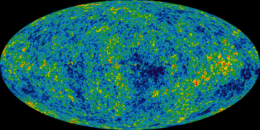
A map of temperature fluctuations in the cosmic microwave background from WMAP. This map shows temperature deviations of up to 200 microkelvin. [NASA / WMAP Science Team]
Since its discovery in 1964, the cosmic microwave background (CMB) has been our main means of studying inflation. The CMB is the earliest light we can detect, made up of the photons that come from the moment the universe cooled enough for light to pass freely through space. To first order, all parts of the CMB are the same temperature, 2.7K. This is strong evidence of inflation because it means all parts of the sky needed to have been in contact at one point before growing to its current size. However, very small fluctuations exist in the CMB, and it is these fluctuations that allow us to more precisely study inflation. The fluctuations are a result of inflation amplifying quantum fluctuations in the early universe, and we can work backwards from the fluctuations to characterize inflation.
To characterize the fluctuations, we collect all the information about the size and strength of the fluctuations into a plot called the power spectrum. The goal of the power spectrum is to understand whether temperatures in the CMB are more correlated at particular spatial scales than others. Constructing the power spectrum is somewhat complex, but you can roughly imagine picking two points on the sky at some set distance apart and checking whether their temperatures are the same, and then repeating this for every set of points on the sky at that same set distance, and then doing the whole thing again at all possible distances. The structure of the resulting plot determines parameters like the geometry of the universe and the density of matter and dark matter. Over the past few decades, we’ve been able to fill in more and more of the power spectrum, and we have now reached a point where further measurements are only limited by photon noise.
So far, the results are well in favor of inflation. However, the difficulty now is to come up with a specific model for how it occurred. Currently over 100 proposed models exist, conveniently packaged into this 777-page document. Dr. Bock says there are two main questions to address to narrow down the options: 1) Is there a primordial gravitational wave background, and 2) so far CMB statistics seem to be Gaussian, but is there a non-Gaussian component? The gravitational wave background would tell us the energy scale of inflation, while the non-Gaussian component would show whether a single decaying field or multiple fields were responsible for causing inflation. So far, the BICEP and Keck arrays have been used to measure CMB polarization, concluding that inflation does not proceed simply along a power law. Meanwhile, the upcoming SPHEREx mission is poised to start measuring patterns in large scale structure, looking for correlations in the geometries of the structure to answer the question of non-Gaussian components and further narrow down the set of potential inflation models.
Newton Lacey Pierce Prize Lecture: Characterizing the Properties of Accreting Neutron Stars Through X-ray Observations, Renee Ludlam (Wayne State University) (by Ivey Davis)
We’ve heard quite a bit about the power of pulsars in astrophysics through the lectures on Monday and Tuesday, but today, Renee Ludlam focuses more generally on neutron stars, the various ways they can exist, and what that can tell us about physics.
As mentioned in previous talks, neutron stars push the extremes of our understanding of physics since we can’t measure such conditions on Earth. They have extreme pressures, densities, and magnetic fields that we could (presumably) never hope to replicate on Earth. Such extremes push our understanding of physics, especially how we describe the radial profiles of density, pressure, and temperature, called equations of state (EOSs). Although we have many ideas for what the EOS of neutron stars might be, it’s difficult to constrain what the correct solution is without being able to identify both the mass and the radius of the neutron star.
Because neutron stars push our understanding of physics to such extremes, we don’t know which model of neutron star interiors is most accurate. In order to constrain this, it’s important to understand the neutron star’s mass (somewhat well constrained in binary systems) and radius (much harder to constrain). Ludlam uses NuSTAR and NICER observations of X-ray binaries in order to put constraints on neutron star radii. These are systems that include a neutron star in a binary system (usually) with a main-sequence star. The neutron star occasionally accretes material from its companion star and produces X-rays. Constraining a neutron star’s radius requires measuring properties of the accretion disk around the neutron star in such a binary. But, this in turn relies on making assumptions about the process responsible for making the accretion disk. By studying the observational properties of accretion onto neutron stars, and how it compares with our models of the accretion, we can start to make conclusions about the system as a whole, as well as about the properties of the individual neutron star.
By observing extreme systems like ultra-compact X-ray binaries, Ludlam has additional spectral lines to study the effects of accretion onto neutron stars, which has helped to further put constraints on neutron star radii. As we continue to observe the unique effects of accretion onto neutron stars, and the various ways that this accretion can occur, there should be more and more stringent constraints on the EOS for neutron stars, and therefore a more robust understanding of physics and how it operates in such extreme circumstances.
